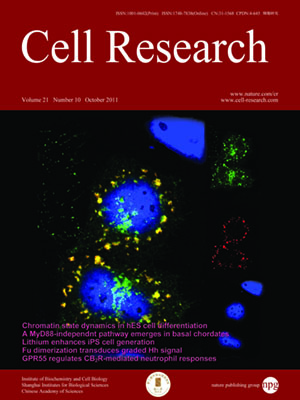
Volume 21, No 10, Oct 2011
ISSN: 1001-0602
EISSN: 1748-7838 2018
impact factor 17.848*
(Clarivate Analytics, 2019)
Volume 21 Issue 10, October 2011: 1410-1423
ORIGINAL ARTICLES
Characterization of bbtTICAM from amphioxus suggests the emergence of a MyD88-independent pathway in basal chordates
Manyi Yang*, Shaochun Yuan*, Shengfeng Huang, Jun Li, Liqun Xu, Huiqing Huang, Xin Tao, Jian Peng and Anlong Xu
State Key Laboratory of Biocontrol, National Engineering Research Center of South China Sea Marine Biotechnology, Department of Biochemistry, College of Life Sciences, Sun Yat-Sen University, 135 W Xingang Rd, Guangzhou 510275, China
Correspondence: Anlong Xu,(lssxal@mail.sysu.edu.cn)
The MyD88-independent pathway, one of the two crucial TLR signaling routes, is thought to be a vertebrate innovation. However, a novel Toll/interleukin-1 receptor (TIR) adaptor, designated bbtTICAM, which was identified in the basal chordate amphioxus, links this pathway to invertebrates. The protein architecture of bbtTICAM is similar to that of vertebrate TICAM1 (TIR-containing adaptor molecule-1, also known as TRIF), while phylogenetic analysis based on the TIR domain indicated that bbtTICAM is the oldest ortholog of vertebrate TICAM1 and TICAM2 (TIR-containing adaptor molecule-2, also known as TRAM). Similar to human TICAM1, bbtTICAM activates NF-?B in a MyD88-independent manner by interacting with receptor interacting protein (RIP) via its RHIM motif. Such activation requires bbtTICAM to form homodimers in endosomes, and it may be negatively regulated by amphioxus SARM (sterile a and armadillo motif-containing protein) and TRAF2. However, bbtTICAM did not induce the production of type I interferon. Thus, our study not only presents the ancestral features of vertebrate TICAM1 and TICAM2, but also reveals the evolutionary origin of the MyD88-independent pathway from basal chordate, which will aid in understanding the development of the vertebrate TLR network.
Cell Research (2011) 21:1410-1423. doi:10.1038/cr.2011.156; published online 20 September 2011
FULL TEXT | PDF
Browse 2164


